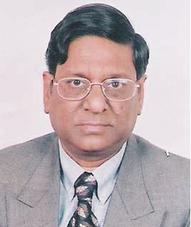Keynote Speakers-------Ram K. Agarwal

Dr. Ram K. Agarwal, Department of Chemistry, Lajpat Rai Postrgraduate College,SAHIBABAD (GHAZIABAD)-201005, INDIA
Speech Title: Designing of Targeting Multifunctional Thiosemicarbazones Derived from Heterocyclic Compounds and Their Metal Coordination Compounds in Biological and Medicinal Inorganic Chemistry
Abstract: Medicinal inorganic chemistry is a multidisciplinary field combining elements of chemistry, pharmacology and toxicology, biochemistry, biophysics and medicinal chemistry.This branch of Chemistry has growing significance in both therapeutic and diagnostic medicine. The history and basic concepts of medicinal inorganic chemistry has been recently reviewed. The unique properties of metal complexes may offer advantages in the discovery and development of new drugs. The development of modern medicinal inorganic chemistry stimulated by the discovery of cisplatin has been facilitated by the inorganic chemists’ extensive knowledge of the coordination properties of metal ions. A broad array of biological and medicinal applications of metal complexes has been investigated and many authors summarize advances in these fields.
The introduction of the sulfur and nitrogen atoms into the structure of organic compounds has often important consequences in their behaviour towards metal ions. From the comparatively large atomic radius of sulfur atom and its lower electronegativity than nitrogen, one expects that sulfur containing ligands will form less stable complexes than those containing nitrogen but it has been observed that this affinity of sulfur for metal ions is often very close to the ligands containing nitrogen as donor atom. Many investigations have been undertaken of the interaction of transition metal ions with nitrogen and sulfur containing ligands. In recent years, sulfur containing ligands such as dithiocarbamates and thiosemicarbazones and their transition metal complexes have received more attention in the area of medicinal chemistry, due to their pharmacological properties, such as antiviral antibacterial antifungal antiparasitic and antitumor activities.
The synthesis of thiosemicarbazones (R–CH=N–NH–CS–NHR1) has been developed due to the facility to replace the R and R1 substituent groups by alkyl, aryl, or heterocyclic derivative and thus leading to a broad spectrum of new bidentate (N,S or N,N) and tridentate (N,N,N or N,N,S) and also tetra- and pentadentate ligands, capable of coordinating to metal centres.
It has been shown that the α-(N)-heterocyclic carbaldehyde thiosemicarbazones act as chelating agents of the transition metals and some of them exhibit antitumor activity by inhibiting the biosynthesis of DNA, possibly by blocking the enzyme ribonucleotide diphosphate reductase . On the other hand, the ligand 6-methylpyridine-2-carbaldehyde-N(4)-ethylthiosemicarbazone (HmpETSC) and its complexes [Zn(HmpETSC)Cl2] and [Pd(mpETSC)Cl] exhibit antineoplastic activity against colon cancer human cell lines (HCT 116) with IC50 values of 14.59, 16.96, and 20.65 μM, respectively.
There is a report on cytotoxic activity of the ligands derived from benzaldehyde and furaldehyde thiosemicarbazone and their palladium(II) bis-chelate complexes. In vitro antitumor studies against different human tumor cell lines revealed that these metal complexes (IC50 = 0.21–12.46μM) were more cytotoxic than their corresponding ligands (IC50 > 60 μM). On the other hand, the platinum(II) tetranuclear, [Pt4L4] (HL = 4-phenyl-1-benzaldehyde thiosemicarbazone), exhibits higher antiproliferative activity with IC50 values in the range of 0.07–0.12μM .
Although in many cases the stereochemistry and electronic structures are reasonably well understood yet the structure and bonding in several metal complexes involving ligands containing nitrogen and sulfur donors have not been satisfactorily worked out. Of the sulfur donor ligands, thiosemicarbazones have perhaps not received asmuch attention as dithiophosphates, dithiocarbamates, dithiolates, dithio-β-diketonates, dithiooxamides or xanthates. A number of thiosemicarbazone ligands have been derived by simply condensing aliphatic, aromatic or heterocyclic aldehydes or ketones with thiosemicarbazide compounds. Many of these compounds possessed wide spectrum of medicinal properties including protozoa, small pox certain types of tumours, tuberculosis, leprosy, bacterial and viral infections, psoriasis, rheumatism, tripanosomesis, coccidiosis, malaria andhave been suggested as possible pesticides and fungicides. Their activity has frequently been thought to be due to their ability to chelate trace metal ions. Liebermeister showed that copper ion enhance the antitubercular activity of para-acetamidobenzaldehydethiosemicarbazone. Petering et.al. showed that the active intermediate in the anti-tumour activity of 3-ethoxy-2-oxobutyraldehyde bis (thiosemicarbazone (H2KTS) was the chelate Cu(KTS).
The biological and medinal activities of the thiosemicarbazones suggest that the molecular features essential for such activities must be ascertained by designing synthetic routes to modify, replace or substitute the derived thiosemicarbazone ligands. From our laboratory,we reported a number of tridentate (N,N,S)containing thiosemicarbazones and their metal coordination compounds and their biological and medicinal properties.
[1] K.H.Thompson and C.Orvig, “ Medicinal Inorganic Chemistry” in Concepts and Model
Systems in Bioinorganic Chemistry., Ed. H.B.Kraatz and N.Metzler-Nolte. Wiley-VCh,
Weinheim, Germany, 2006
[2] Ram K.Agarwal and S.Prasad, Turk. J.Chem., 29, 289-297(2005)
[3] S.Prasad and Ram K.Agarwal, Transition Met.Chem., 32, 143-149 (2007)
[4] S.Prasad and Ram K.Agarwal, J.Korean Chem.Soc., 55, 189-198 (2011).



